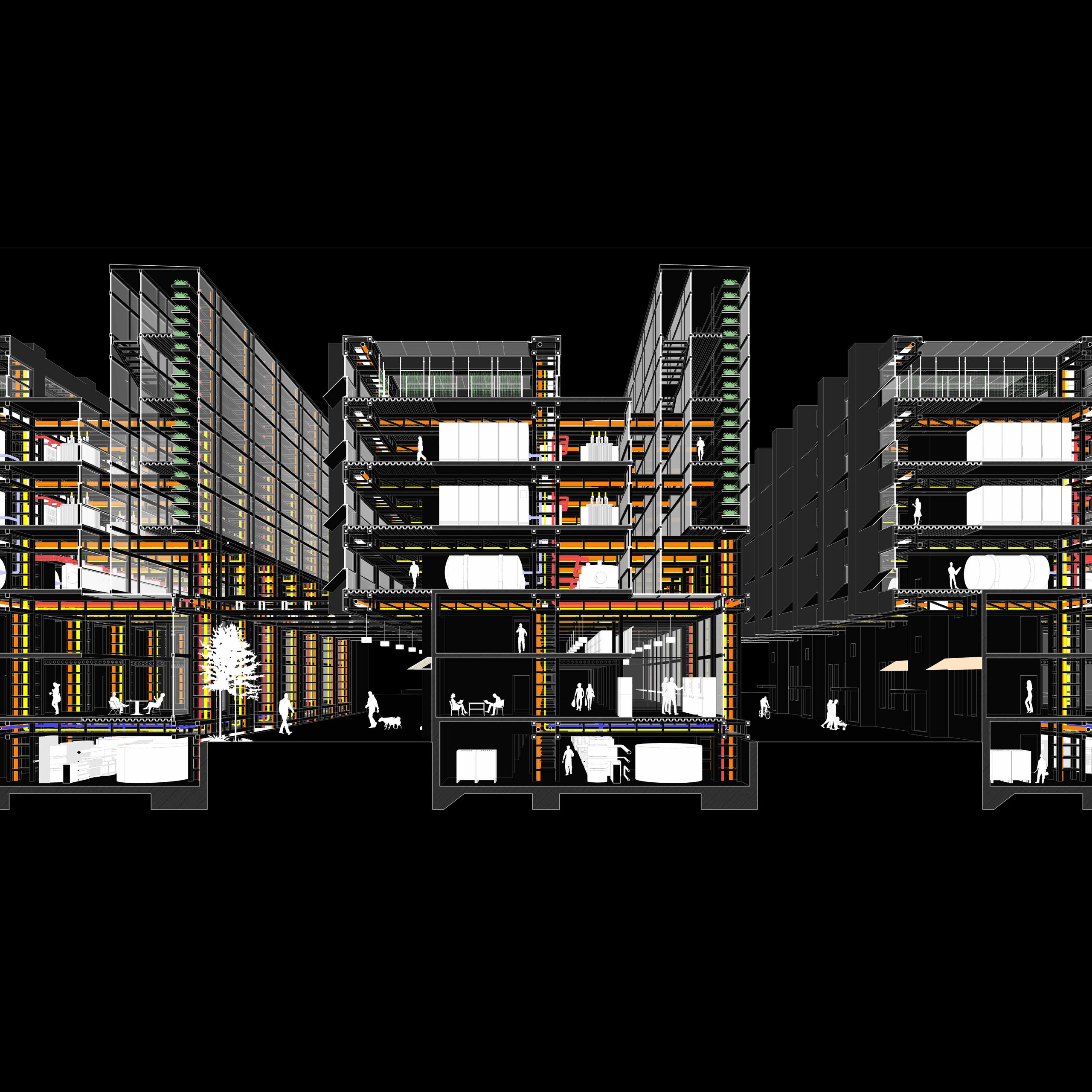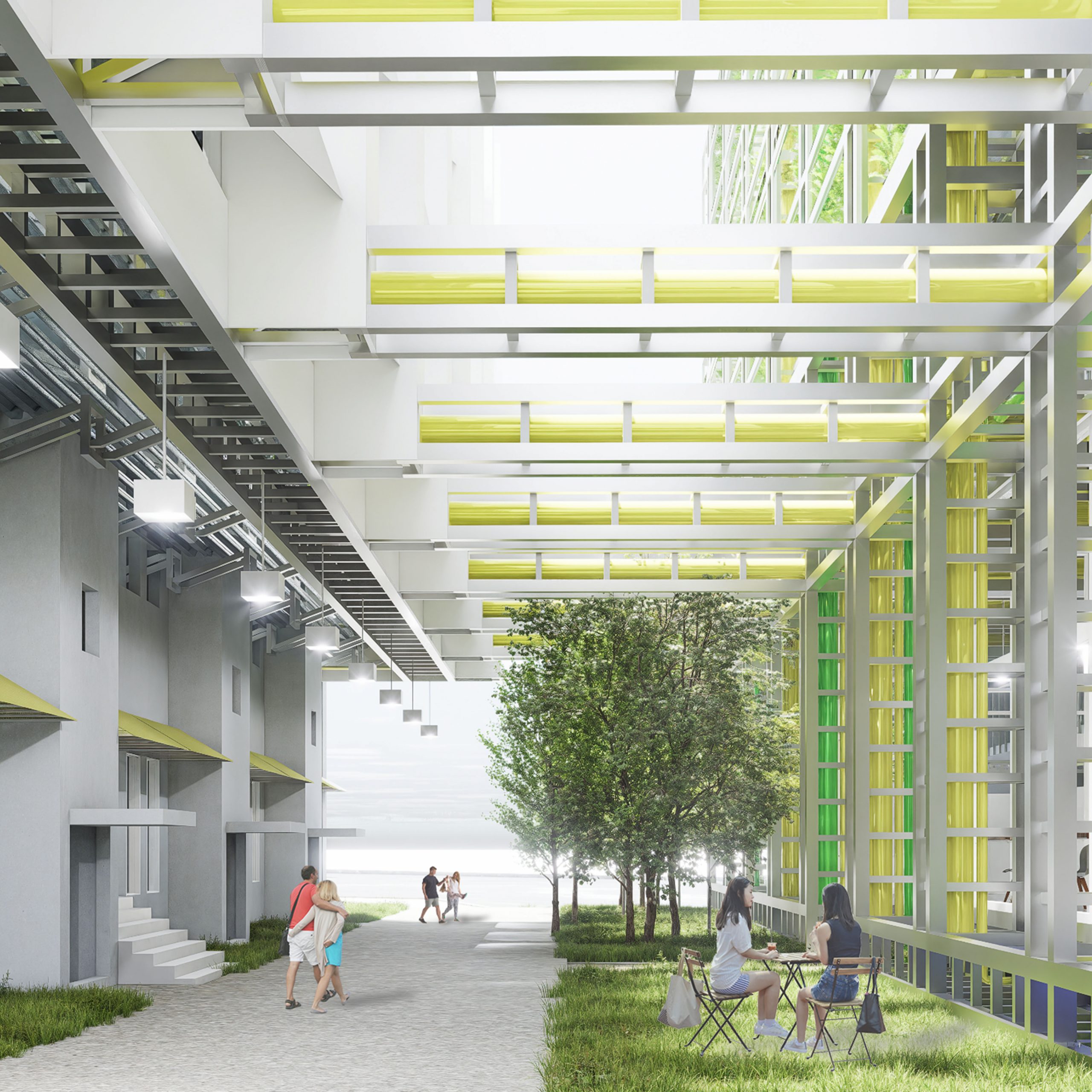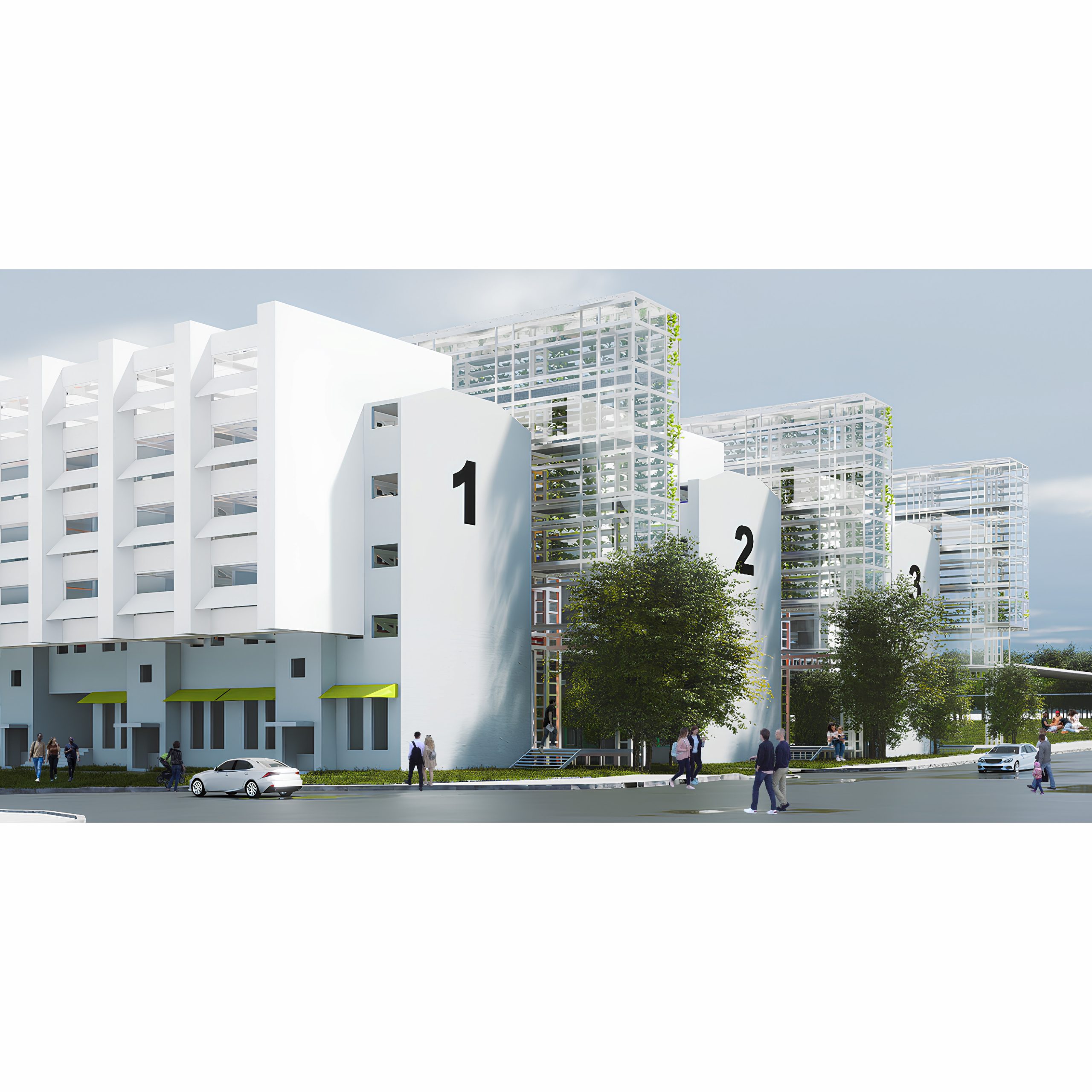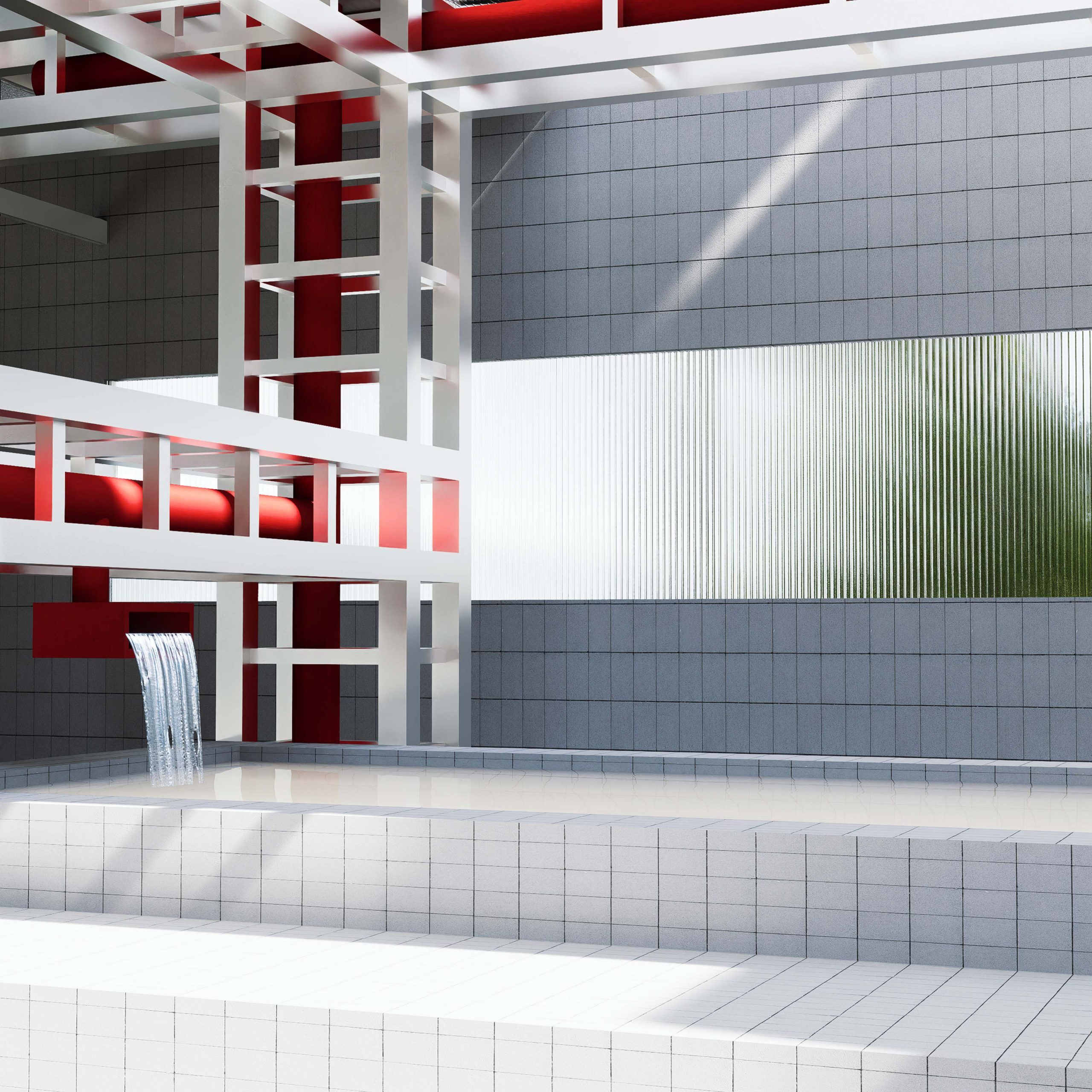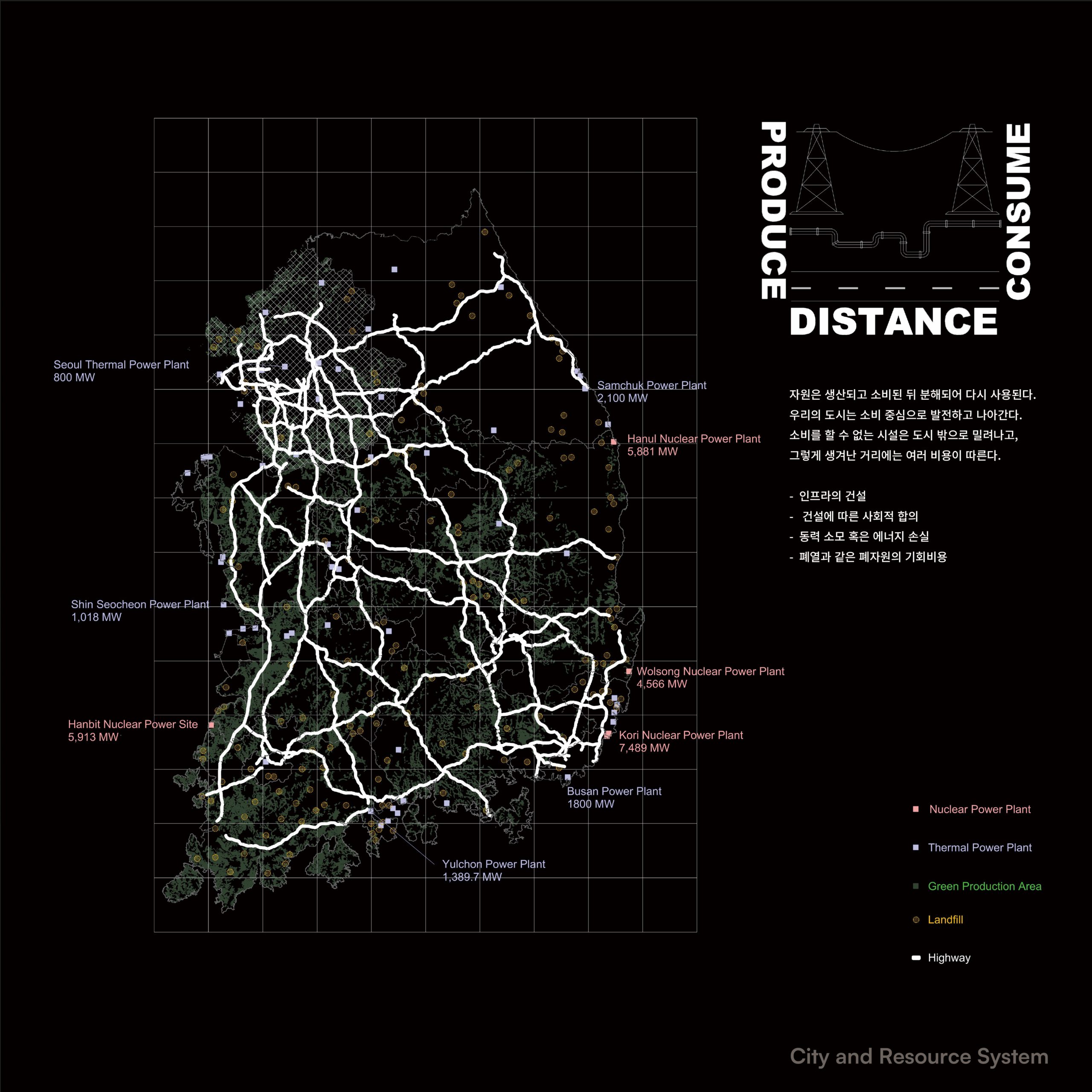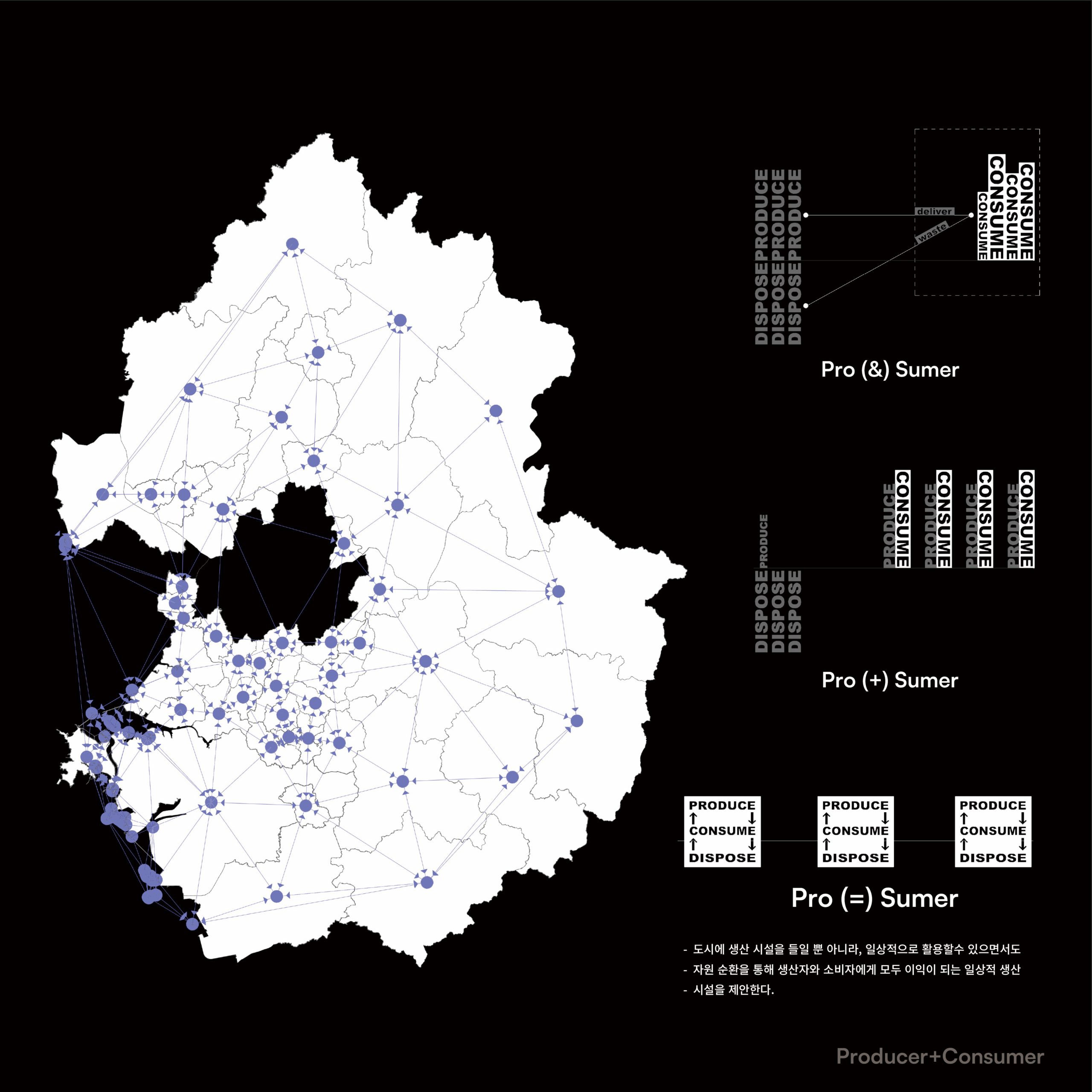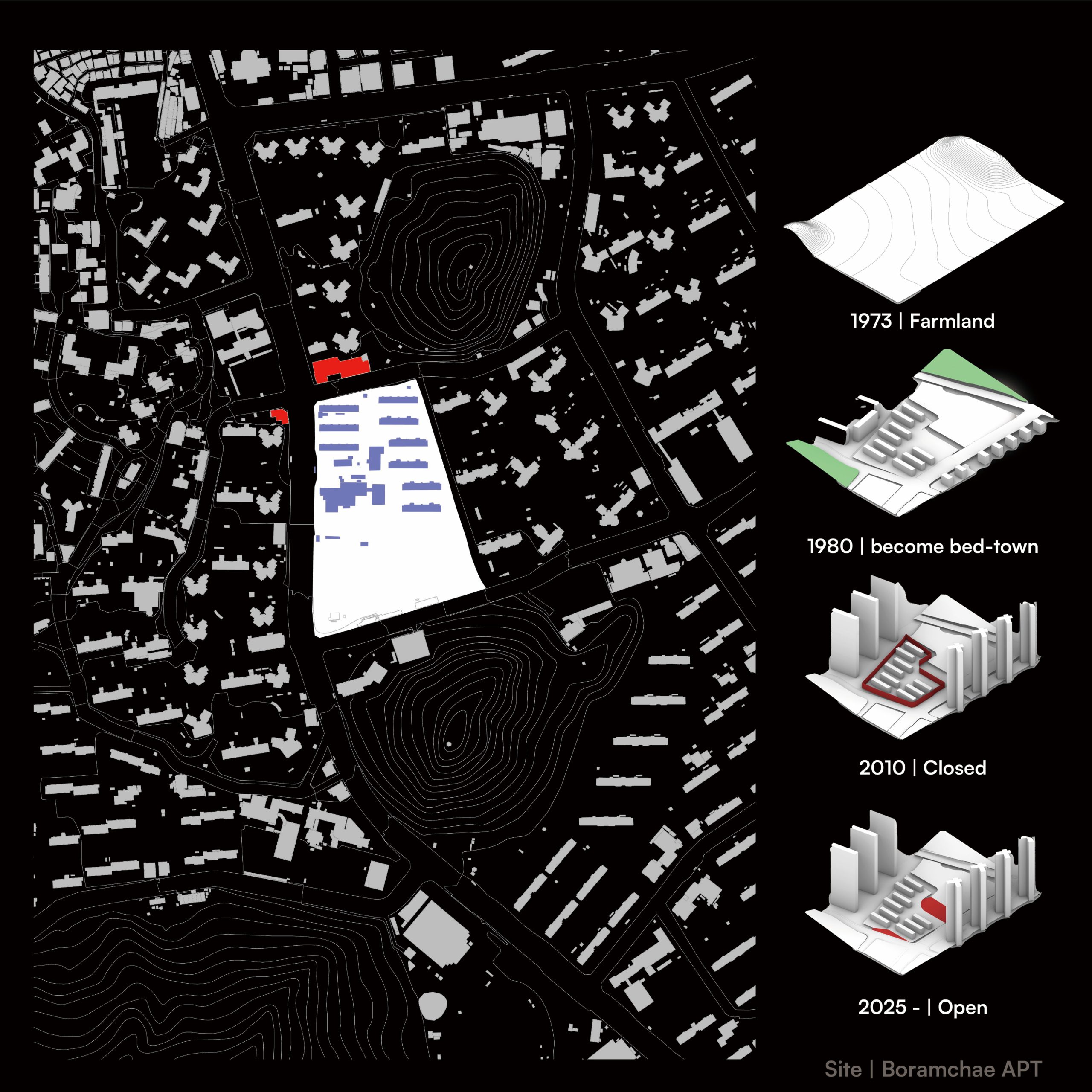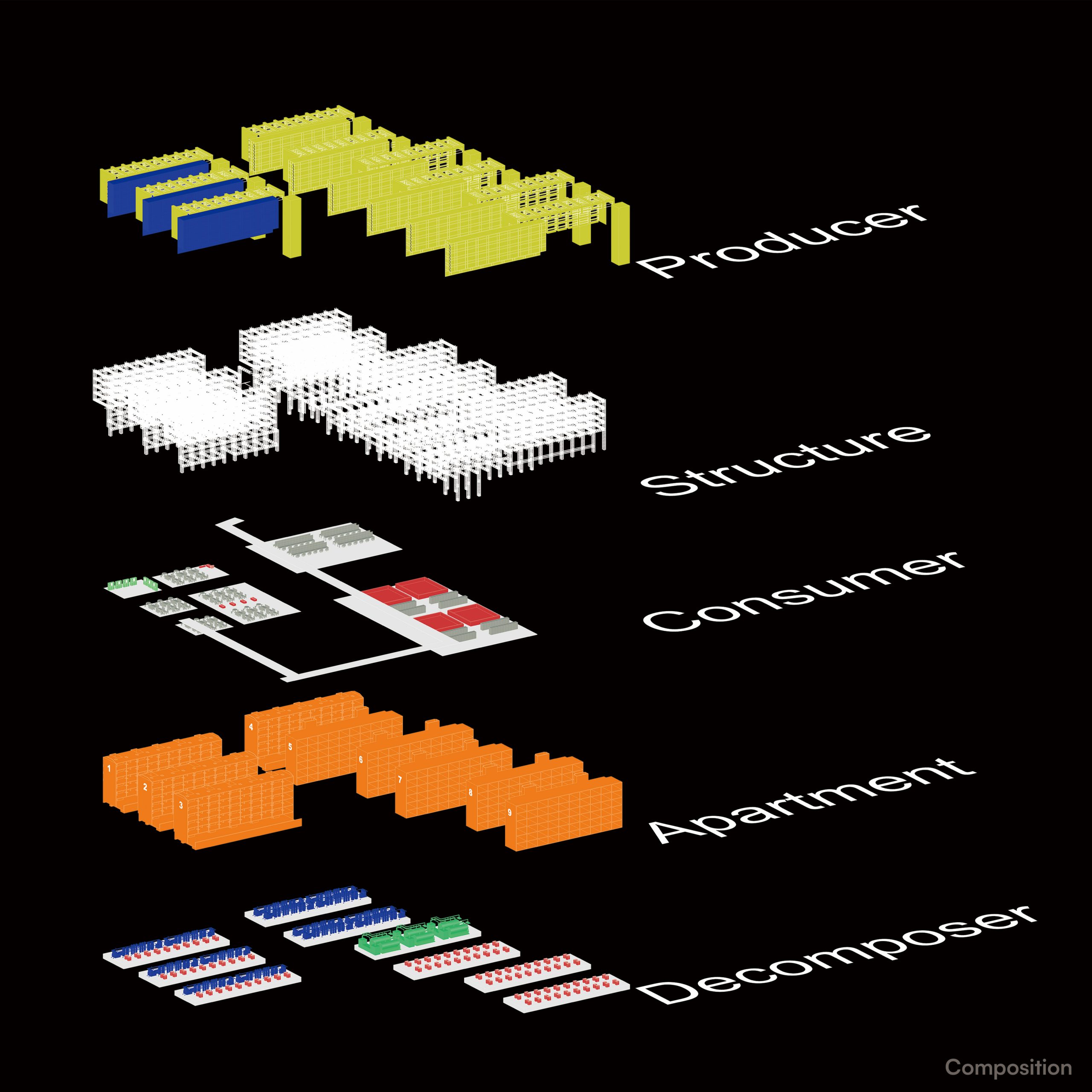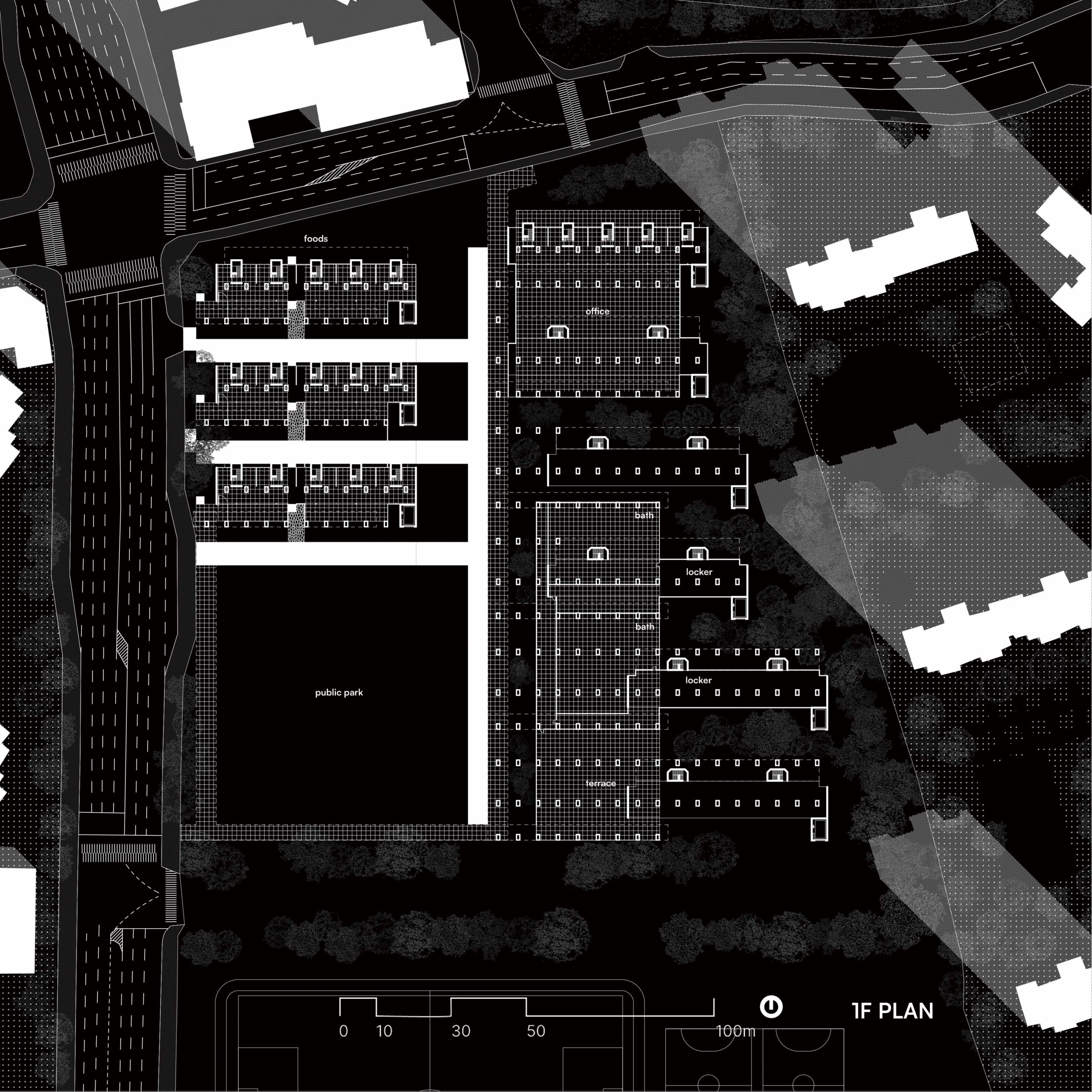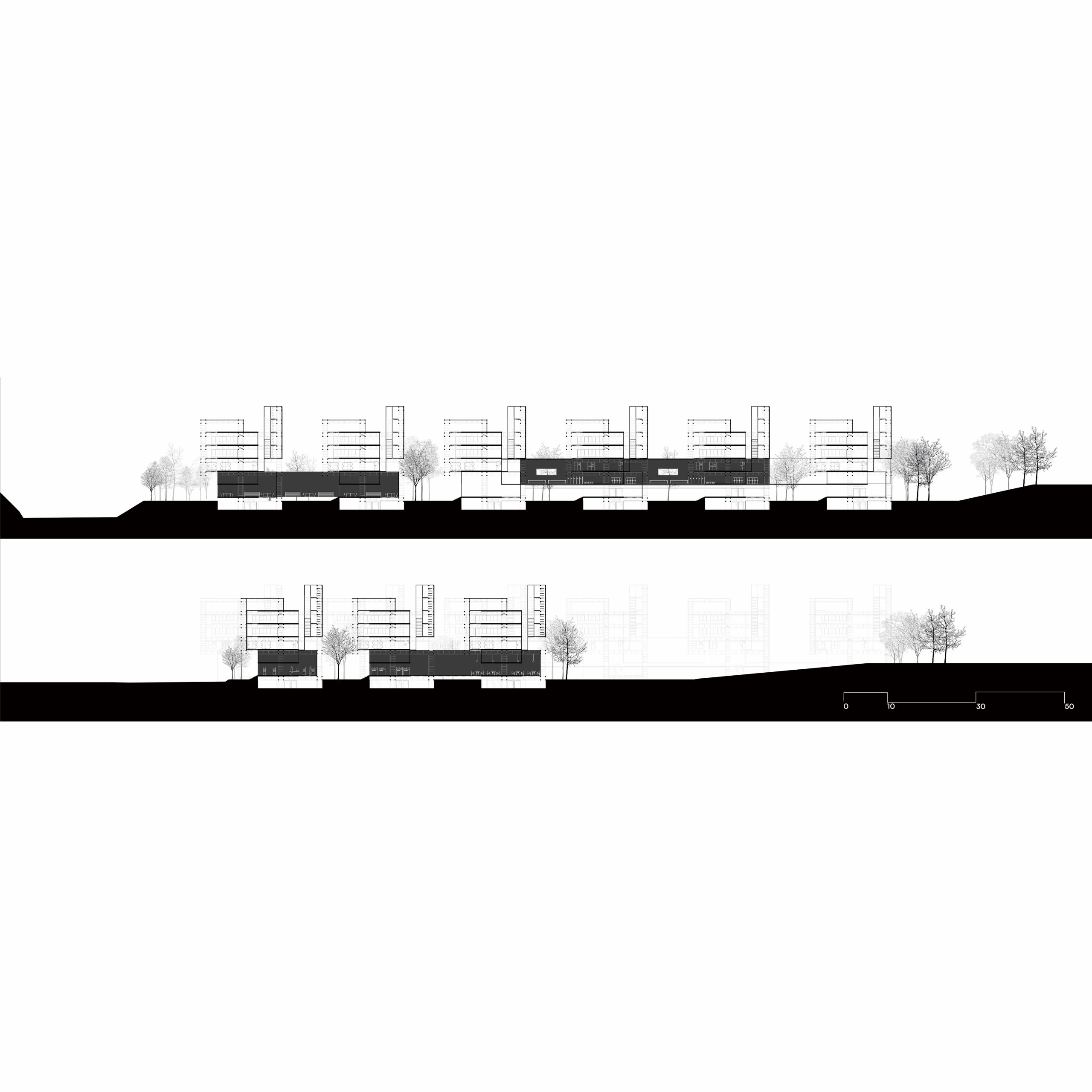장동혁 _ (Re-) Plant : 생산 시설과 공생하는 소비의 도시
거리의 비용
자원은 생산-소비-분해의 순환을 거치고, 우리가 일상을 살아가는 도시는 소비 중심으로 나아가고 발전한다.
발전소, 농장과 같은 생산을 위한 시설은 점점 도시 밖으로, 아파트나 상업 공간과 같은 직접 점유하고 자원을 소비하는 공간은 도시 안으로 모인다.
그렇게 멀어진 생산 시설과 소비의 도시 사이의 거리는 보이지 않는 환경적, 경제적 비용을 만들고, 도시는 지속가능한 시스템에서 멀어져간다.
새로운 인프라의 건설과 그에 따른 사회적 합의의 비용, 자원을 조달하는 데 필요한 동력과 자원, 송전 손실, 재사용 가능한 폐자원에 대한 기회 비용이 그것들이다.
Prosumer : Producer = Consumer
도시 안에 생산시설을 다시 들여 우리의 일상 가까이에 두는 것은 거리의 비용을 감축하는 방법이다.
그러나 거대한 생산 시설이 도시로 들어오는 것은 일상 속에서 점유할 수 없는 불가침의 영역을 만들고 직접 편의를 제공하지 않는다.
프로젝트는 소비 중심의 일상과 생산 시설의 조화로운 공생에 대해 고민한다.
도시의 입장에서는 식량과 전력을 생산하는 생산자이자, 시민의 입장에서는 먹고 씻는 일상의 연장선이 되는 공공형 생산시설을 계획했다.
버려진 아파트가 그리는 지속가능한 도시
광명시는 수도권 내의 베드타운으로서 28만 명이 일상을 살아가는 도시이다.
1970년대까지 거대한 농경지였던 광명시는 구로공업단지 계획과 연계되어 주거밀집지역으로 개발되어 왔고,
보람채아파트는 구로공단 근로자를 위한 임대아파트로 지어졌다.
이후 서울과 광명에 더 많은 사람들이 모이게 되면서 도심 속 공업단지는 문을 닫고 오피스로 변했고,
의미를 잃은 보람채아파트는 폐쇄되어 10년 간 방치되었다.
아파트를 덮어쓴 생산의 땅 위에서 본 프로젝트는 또 다른 아파트가 아닌, 도시의 미래를 위한 새로운 시설의 모습을 그려내려 했다.
일상의 지평면
생산의 영역과 일상, 혹은 소비의 영역을 평면적으로 이분하는 기존의 구도는 서로를 불가침의 영역으로 만든다.
프로젝트의 출발점은 두 영역의 자리가 입체적으로 재조직되어 도시 맥락에서 연장되는 일상의 지평면을 보존하는 것이다.
발전소와 농장과 같은 생산시설은 고층부에 자리잡아 햇빛을 받고 공기의 흐름을 조절함과 더불어 비를 피하고 걸을 수 있는 아케이드의 지붕이 된다.
아파트의 저층부는 음식을 먹고 몸을 씻는 일상적 행위가 담기는 공공공간이 되어 언제든 들어왔다가 나갈 수 있는 모두의 공간으로 재사용된다.
자원의 순환과 상리공생
나아가 생산의 주산물 뿐만 아니라, 본디 버려질 부산물을 일상의 공간에서 활용하고, 일상적 폐기물을 재생하여 생산의 원료로 사용하는 자원 순환을 담는다.
연료전지 발전기에서 생기는 전기와 폐열, 열수는 조리, 난방, 온수로 재사용되고, 음식물 쓰레기와 일상폐수는 자원 재생 기술을 통해 수소를 추출하는 원료가 되어 다시 발전에 사용된다.
무거운 생산 설비들을 지탱하기 위해 새롭게 관입되는 경량철골 프레임의 빈 속은 순환되는 물질들이 이동하는 통로의 역할도 맡는다.
이로써 사람이 살던 아파트는 모듈화된 생산 설비들의 방이자, 시민 모두가 쓰는 공공 공간이 되고, 지하의 기계실은 자원 재생의 공간으로 재활용된다.
도시의 시스템은 풍경으로 드러난다. 자본주의적 관점에서 진행되는 주거단지 재개발은 우리가 아는 세련되지만 지루한 그 풍경을 만든다.
위기는 드러나지 않는다. 위기는 시스템을 바꾸고,
그렇게 새로운 풍경이 되어 일상의 경험을 재편한다.
The Cost of Distance
Resources undergo a cycle of production–consumption–decomposition, and the cities where we live our daily lives develop with a focus on consumption.
Facilities for production, such as power plants and farms, are pushed further outside the city, while spaces that directly occupy and consume resources, such as apartments and commercial areas, gather within the city.
This growing distance between production facilities and the city of consumption creates invisible environmental and economic costs, moving cities further away from a sustainable system.
These costs include the expenses of building new infrastructure and the social agreements that follow, the energy and resources required to procure resources, power transmission losses, and the opportunity cost of reusable waste materials.
Prosumer: Producer = Consumer
Bringing production facilities back into the city and placing them close to our daily lives is a way to reduce the cost of distance.
However, massive production facilities re-entering the city create untouchable zones that cannot be occupied in everyday life and do not directly provide convenience.
This project explores the harmonious coexistence between a consumption-centered daily life and production facilities.
It proposes a public production facility that, from the city’s perspective, produces food and energy, and from the citizen’s perspective, extends the daily acts of eating and washing.
An Abandoned Apartment Envisions a Sustainable City
Gwangmyeong City, a commuter town within the Seoul metropolitan area, is home to 280,000 people living their daily lives.
Until the 1970s, Gwangmyeong was vast farmland, but with the Guro Industrial Complex project, it was developed into a densely populated residential area.
Boramchae Apartment was built as a rental apartment for workers in the Guro Industrial Complex.
As more people gathered in Seoul and Gwangmyeong, the inner-city industrial areas closed and turned into office spaces, and Boramchae Apartment, having lost its purpose, was closed and abandoned for 10 years.
On this land of production covered by apartments, this project aims to envision not another apartment, but a new facility for the future of the city.
The Horizon of Everyday Life
The conventional structure that divides the realms of production and everyday (or consumption) horizontally creates untouchable zones between them.
The project begins with preserving the horizon of everyday life extended within the urban context by reorganizing these two realms three-dimensionally.
Production facilities like power plants and farms occupy the upper levels, receiving sunlight, managing airflow, and becoming roofs of arcades that provide shelter from the rain while allowing people to walk.
The lower levels of the apartments become public spaces that host everyday activities like eating and washing, transforming into spaces open for everyone to enter and leave freely.
Resource Circulation and Mutual Symbiosis
Going further, the project seeks to utilize not only the main products of production but also by-products that would typically be discarded, and to regenerate everyday waste into raw materials for production, embracing resource circulation within everyday spaces.
Electricity, waste heat, and hot water generated by fuel cell generators are reused for cooking, heating, and hot water, while food waste and daily wastewater are converted into hydrogen through resource regeneration technologies and used again for power generation.
The hollow interior of the newly inserted lightweight steel frame, which supports the heavy production equipment, serves as passageways for the circulation of these materials.
In this way, the apartment once inhabited by people becomes both rooms for modular production facilities and public spaces for all citizens, while the underground mechanical rooms are repurposed as spaces for resource regeneration.
The city’s systems become visible in its landscape. The capitalist-driven redevelopment of residential complexes creates the sleek yet monotonous landscapes we know.
Crises do not reveal themselves. Crises change systems,
and in doing so, they become new landscapes that reconfigure the experiences of daily life.
